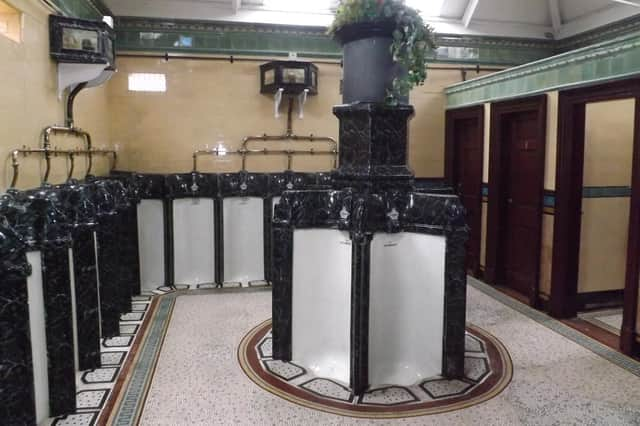Scotland's toilet history from the cold cludgie to the comfortable convenience - Susan Morrison


In the days before indoor plumbing, human waste was a valuable commodity. Burgh scavengers collected and sold the contents of the chamberpot and the close-stool to the market gardeners. They used it to fertilise the crops for the tables of the good folks of the toon to eat, who let nature take its course and the scavengers came around again.
Recycling is nothing new.
The system worked whilst Scotland's cities were small, but no scavenger team could cope with the population explosion following the industrial revolution. The cities started to drown in human waste, with terrible consequences.
Advertisement
Hide AdAdvertisement
Hide AdIn 1848, Dr James Maxwell Adams wrote of the diabolical conditions in Glasgow. In one small district of about half a mile long and a quarter wide, he estimated roughly 14,000 people lived in utter squalor
There were few sewers. Waste piled up in the closes. “Receptacles for filth” were stored in the “lower flats of inhabited tenements, with an open window through which the refuse is cast.”
The excrement really hit the fan with the great cholera epidemic of 1848. Edinburgh and Glasgow took a beating. On December 9th, Dr Adams attended a woman in Shuttle Street. She was taken to hospital, but she died the next day. By the 12th, a two year old child displayed the symptoms of cholera. She also died. The cases came thick and fast and by Christmas Eve the good doctor was ricocheting from dying patient to dying patient.
The jury was still out about the transmission of cholera. Was it carried by the air, in the foul stench known as miasma, or through the water? Either which way, Scotland decided something must be done and began the shift to the indoor toilet.
Inside loos were not new. There’s archaeological evidence that the residents of Skara Brae had a special stone hut with a drain. It was pretty basic. The waste was probably washed away using jugs or pots of water, but it's the same idea.
Chamber pots and close stools had always been around.
Flushing toilets were also known. In 1775, Scottish watchmaker Alexander Cumming was granted the first patent for a flushing toilet complete with an ‘S-shaped trap’, very like today’s u-bend, ‘so constructed that its contents shall or may be totally emptied every time the closet is used’.
Sadly, he had to wait until the sewage system caught up with his invention, but once the Victorians got an idea in their heads, there was no stopping them. Both great cities of Scotland went sewer building mad, and with it came the flushing toilet, quickly to become known as ‘the cludgie’.
For the common folk, the cludgie was a communal affair. The landings and half landings of tenement stairs became the lair of the loo, shared between up to six families. There are still people today telling terrifying tales of childhood late night trips to the freezing lavvy on the landing. If the locks were damaged, whistling in the dark was the only way to preserve your privacy.
Advertisement
Hide AdAdvertisement
Hide AdCarefully torn strips of newspaper were on hand, but not to read. They were used as toilet tissue. Those who were flush might shell out for the hard, unyielding but sanitary Izal paper, a name to trigger an involuntary twinge in the nether regions in some Scots..
Scotland, of course, sold its own industrial strength toilet tissue. John Miller and Sons, Wholesale Stationers, 116 Renfield Road, advertised Excelsior toilet roll, which promised to be a ‘strong quality with a smooth surface’. A dozen rolls for 3/6. Bargain.
Paisley became a global leader in the manufacture of toilets for home, factory and even thrones for royalty. John Shanks was a Paisley plumber born in 1826 who decided at the age of twenty to go it alone at a most excellent time. He moved into toilets and taps during a building boom, and those buildings now had to have sanitation. Doctors had made the link between disease and dirty water. His company merged with Armitage to give us the mighty Armitage Shanks name we see today.
Robert Brown and Son, also of Paisley, provided the three-piece bathroom suite for the Kaiser's yacht. Doulton was so impressed by the town that they opened a factory there and put the name Paisley on one of their best-selling pedestals. It was probably meant as a tribute, but putting a town’s name on a cludgie was probably not the complement it was intended to be.
The cisterns of Victorian toilets were magnificent, with brand names like Thunderer and Niagara. The gravity feed they used to flush truly thundered when the big chain was pulled. You could hear them at street level from the public toilets, such as the set in Glasgow’s St Vincent Street. Occasionally you can still find ‘Thunderers’ in houses and flats that haven’t been renovated, but if you really want to appreciate the beauty of a high-rise flush then a trip to Rothesay is in order.
The public toilets at the head of Rothesay pier are magnificent. The tile work, pedestals and pipe work are testaments to late-Victorian sanitary engineering, and, although the cisterns are not original, they faithfully follow the ideal that higher is better.
Of course, if you are a lady, you will have to ask to view this temple of toilets. This convenience was built purely for the gents. Ladies’ toilets were not added until 1994. No, the gentler sex was not supposed to need the loo.
These days it’s soft tissue and a quiet push button flush. Some toilets even have heated seats. Just be grateful for that comfortable convenience. It's all a far cry from the dark cold cludgie on the landing or cholera on tap.
Comments
Want to join the conversation? Please or to comment on this article.